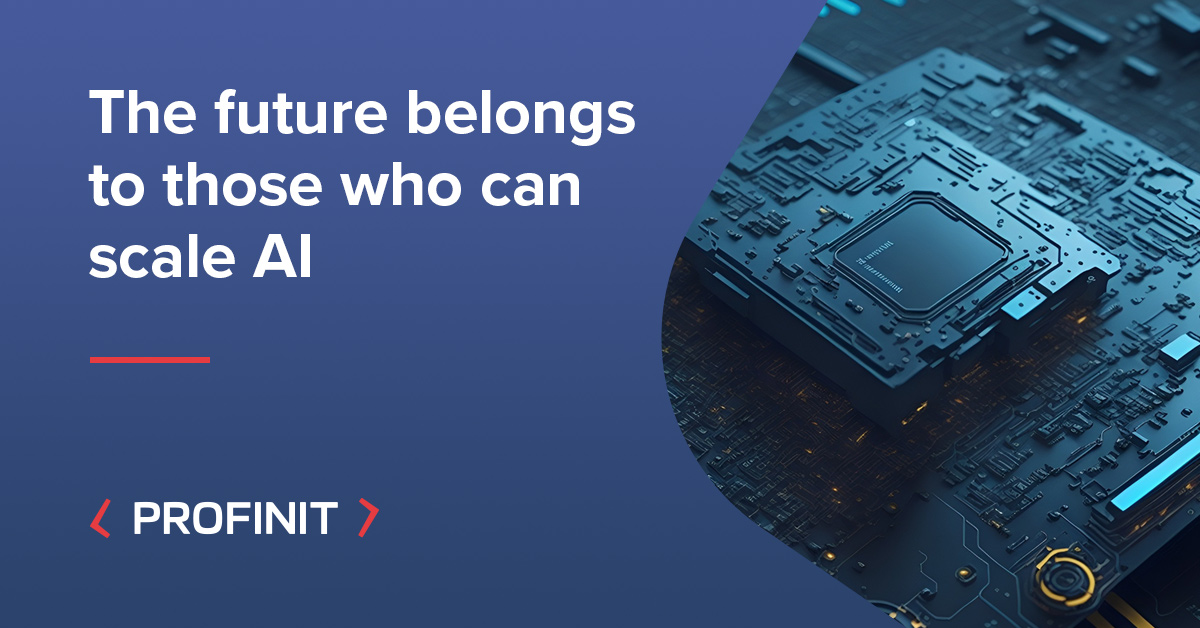Artificial intelligence (AI) is no longer a futuristic promise; it’s a transformative force reshaping industries. AI is at the heart of innovation, from driving down costs to streamlining operations and uncovering new revenue opportunities. High-performing organizations are capitalizing on AI more broadly, allocating over 20% of their digital budgets to AI initiatives and already attributing more than 10% of their EBIT to the use of generative AI(1). However, many companies still find themselves stuck in pilot stages, unable to scale AI across the enterprise effectively.
The barriers to scaling AI aren’t new. Issues like fragmented data systems, unclear ROI, and skill gaps have long plagued AI adoption. What is new is the urgency. Predictions from Gartner and McKinsey highlight that the stakes are higher than ever. According to Gartner, 30% of generative AI projects are predicted to fail by 2025 due to poor data quality(2). McKinsey also warns that the risks of feeding poor data into generative AI models cannot be overstated(3). Projects that fail to address data quality and alignment with business objectives are destined to fall short.
But the solution isn’t just about fixing what’s broken. Success comes from leveraging AI’s growing capabilities, aligning them with business goals, and tailoring them to specific industries. This is where forward-thinking organizations can break the bottleneck and turn AI into a true competitive advantage.
Main barriers to scaling AI
The journey from AI pilot to enterprise-wide adoption often stalls due to a mix of technical, regulatory, and organizational barriers. Prime among them is the issue of data silos. Disparate systems house critical information, but the lack of integration means AI models operate without the complete picture. Add to this poorly defined metadata(4), and the result is reduced accuracy and scalability.
For industries like banking and healthcare, balancing innovation with adherence to stringent privacy and security mandates can slow progress.
Even with strong technology foundations, the human factor can’t be overlooked. Many organizations lack the in-house expertise required to manage and scale AI effectively. Specialists in data engineering, machine learning, and prompt engineering are in high demand, and the competition to attract this talent is fierce.
Finally, pilot fatigue is all too common. Many AI projects deliver promising proofs of concept but fail to demonstrate quick, tangible returns on investment. Securing stakeholder buy-in and scaling initiatives becomes even more challenging without early wins.
AI’s potential
Despite these challenges, the potential of AI to transform business processes is undeniable.
- Faster data retrieval
AI significantly reduces employees’ time searching for information across documents, databases, and communications. Instead of hours, critical insights are available in seconds. - Pattern recognition and anomaly detection
AI models excel at identifying trends and irregularities in data. - Content creation
By automating tasks like drafting reports, creating presentations, or generating summaries, AI frees employees to focus on strategic work and dramatically cuts content creation time. - Human-like interactions
Virtual assistants and chatbots handle routine queries and tasks by communicating in natural language.
Core applications of GenAI
We have identified 3 main types of use cases
- Q&A Bots for knowledge bases let users interact with them and access information in client knowledge bases, preventing risk of leaking (private data), answers are controlled, and key documents are referenced
Case study: Raiffeisenbank CZ reduced back-office support time by 75% using a GPT-based AI Assistant on Microsoft Azure. Strict banking regulations were adhered to while enabling accurate, real-time query responses. Learn more about the case study.
- Examination tools allow users to process specific documents of variable structure; these are useful for comparing documents, identifying key information and extracting this data in a structured format.
Case study: A German private bank deployed an AI Contract Review Assistant for DORA compliance, improving processing speed by 70%, cutting negotiation timelines with ICT service provider from weeks to minutes.
- Virtual assistants for process automation are the most complex use case, combining several AI models to execute tasks. They work as user interfaces to streamline well-defined processes.
Case study: Profinit and FLÆ Robotics have collaborated on an AI-powered receptionist called BE-A. This receptionist manages check-ins, handles repetitive queries, and integrates with hotel systems, freeing staff to focus on guest experience.
A practical roadmap to AI scaling
For organizations seeking to scale AI, the path forward lies in addressing foundational issues while building on early wins.
- Unify data and improve metadata
Integrating data across systems and defining consistent metadata standards ensures AI models operate with complete, reliable information. - Start small and scale strategically
Begin with well-defined, repetitive tasks demonstrating quick returns. Use these wins to build momentum for more complex initiatives. - Upskill and partner
Bridging the AI talent gap requires a dual approach: investing in internal training programs while leveraging external expertise. Partnerships with AI solution providers can accelerate progress without overburdening internal teams. - Embed governance from day one
Compliance isn’t optional. Incorporate regulatory requirements into AI project planning and continuously monitor for updates to avoid disruptions. - Focus on ROI and KPIs
Define clear, measurable outcomes for every AI initiative. Metrics like time saved, error reduction, or cost savings provide tangible evidence of value, ensuring stakeholder support for broader rollouts.
Conclusion
AI’s transformative potential is undeniable, but its success isn’t guaranteed. Organizations must approach AI adoption with a strategic mindset, ensuring data quality, regulatory compliance, and alignment with business objectives. The shift toward industry-specific AI solutions further underscores the need for customization and collaboration.
Author: Marek Pauš
References
- McKinsey & Company. (2024, May 30). The state of AI in early 2024: Gen AI adoption spikes and starts to generate value. Retrieved from https://www.mckinsey.com/capabilities/quantumblack/our-insights/the-state-of-ai
- McKinsey & Company. (2024, July 8). A data leader’s technical guide to scaling GenAI. Retrieved from https://www.mckinsey.com/capabilities/mckinsey-digital/our-insights/a-data-leaders-technical-guide-to-scaling-gen-ai
- (2024, April 12). 3 bold and actionable predictions for the future of GenAI. Retrieved from https://www.gartner.com/en/articles/3-bold-and-actionable-predictions-for-the-future-of-genai
- (2025, January 8). The power of metadata-driven automation. Retrieved from https://profinit.eu/en/blog/the-power-of-metadata-driven-automation/
